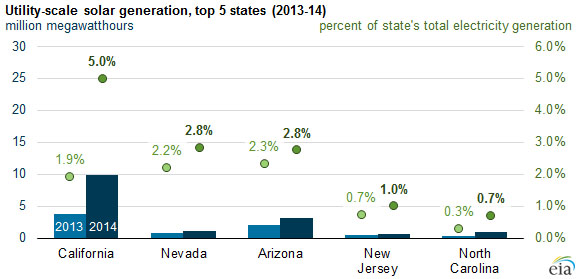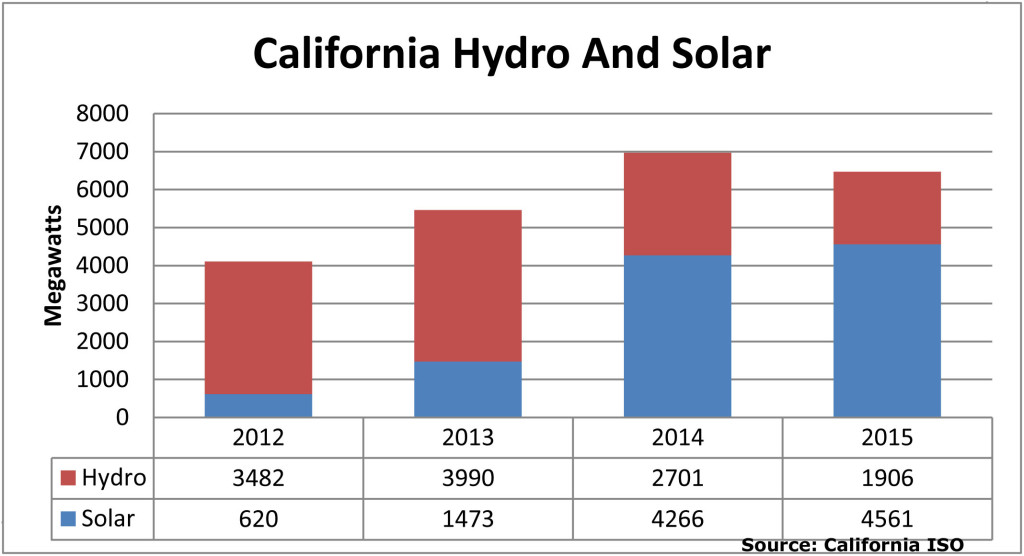California notched another first last year—becoming the first state in the nation to generate more than 5 percent of its electricity from utility-scale solar according to data released last month by DOE’s Energy Information Administration.
All told, EIA said, the state’s utility-scale solar units (defined as those being 1 megawatt or larger) generated a record 9.9 million megawatt-hours (mwh) of electricity in 2014, a whopping 6.1 million mwh increase over 2013. The sharp uptick in output was due largely to the completion and entry into commercial operation of four large facilities—two 550 MW plants (Topaz and Desert Sunlight), the 377 MW Ivanpah unit and the 250 MW Genesis facility. Overall, California added almost 1,900 MW of utility-scale solar to the grid in 2014, bringing the Golden State’s total to 5,400 MW.
And barring the unforeseen, the generation records will keep falling for the next several years.
In its most recent Electric Power Monthly (published in March with data through January, 2015), EIA noted that California’s utility-scale facilities generated 655,000 mwh of electricity in the first month of 2015, up 68 percent from the 388,000 mwh produced in January, 2014. In addition, the state’s solar building boom is expected to continue through the end of 2016, when the existing federal investment tax credit is slated to drop to 10 percent from the current 30 percent. For example, in its latest Short-Term Energy Outlook, published earlier this week, EIA said it “expects that utility-scale solar capacity will increase by 75 percent between the end of 2014 and the end of 2016, with about half of this new capacity being built in California.” And just in the last month, the agency said, it has added 1 gigawatt of new utility-scale solar to its 2016 projections due to new information from utility companies and solar developers.
Left out of this data, put still pumping electricity into the California market are the small-scale distributed units that EIA doesn’t track. According to statistics on California’s state-run Go Solar page (which can be found here), there are 2,374 MW of small-scale solar capacity installed on homes and businesses throughout the state.
Arizona and Nevada are next in line, with utility-scale solar projects accounting for 2.8 percent of each state’s annual electricity generation. New Jersey is the only other state at or above 1 percent, with utility-scale projects there generating 1 percent of the Garden State’s electricity needs in 2014.
Interestingly, the surge in California solar generation has coincided with the onset of the state’s severe drought, which has driven hydropower generation down by 46 percent from the previous five-year rolling average according to EIA. Admittedly, PV solar is only available during the day, but EIA says that the increase in the state’s solar generation in 2014 offset more than 80 percent of the decline in hydro generation.
A random look (see chart below) at generation statistics from the California ISO’s web site for April 7, 2015, clearly shows the opposing trends. While solar generation shot up from 620 MW in 2012 to more than 4,500 MW this year, hydro dropped by almost 55 percent, falling from 3,482 MW to 1,906 MW that day.
Given that the drought shows no signs of easing—indeed, with the state’s critical snowpack levels at record-low levels, California Gov. Edmund Brown announced mandatory water use restrictions earlier this month—state residents should be thanking their lucky stars that the solar industry boom is solidly on track for more record growth.
–Dennis Wamsted


 Follow
Follow